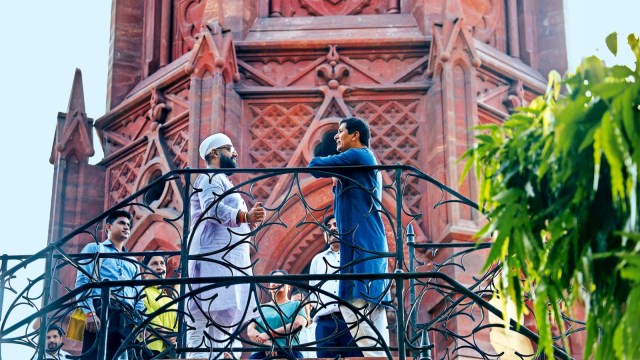This winter, explore Delhi’s famous and unexplored monuments — one heritage walk at a time
The Delhi Tourism Department is organising a Heritage Walk Festival, as part of which it will hold 100 Heritage Walks each day until December 31. Thursday’s walk was at the Mutiny Memorial, renamed Ajitgarh, near Kashmere Gate
 Minister Saurabh Bharadwaj and author Vikramjit Singh Rooprai at the Mutiny Memorial, Thursday. (Tashi Tobgyal)
Minister Saurabh Bharadwaj and author Vikramjit Singh Rooprai at the Mutiny Memorial, Thursday. (Tashi Tobgyal)As the mutiny of 1857 broke out, the British sent a telegram to Ambala from the spot where the Telegraph Memorial now stands near Kashmere Gate. Reinforcements arrived and the rebellion was eventually quelled. “Had they been a little late in sending that message, it could have taken much longer for reinforcements to arrive. It might have given the mutineers more time to act. And perhaps, the fate of Delhi would have been very different from,” said author and heritage activist Vikramjit Singh Rooprai as he narrated the story of India’s first battle of Independence at the Mutiny Memorial on a warm October morning on Thursday.
Built to commemorate slain Britishers, the monument, renamed Ajitgarh, is now a memorial for Indians who lost their lives fighting colonialism. Constructed over 160 years ago, and standing tall with its imposing conical design and gothic architecture, the memorial is a striking structure in Delhi’s Northern Ridge. However, few visit it and it is rarely on the itinerary of any traveller to Delhi.
To change this, the Delhi Tourism Department has organised a Heritage Walk Festival — which kicked off at Ashokan Pillar, a short walk away from the Mutiny Memorial — Thursday. As part of the festival, the department will organise 100 Heritage Walks until December 31.
Among those who confessed ignorance about the Mutiny Memorial was Delhi Tourism Minister Saurabh Bharadwaj. “I grew up in South Delhi but had no idea about this impressive structure until a few days ago. Such initiatives are important for people to know about and be proud of the rich history of our country,” he told The Indian Express.
Bharadwaj, though, had his own interesting heritage-related anecdotes to share. “I grew up in Chirag Dilli. We had a well there that was called sadela (rotten) kuan’. It was actually a hackneyed version of sureela (melodious) kuan since the water was sweet. There was this legend about a buffalo appearing from somewhere in that well. On digging deeper, people found out that the buffalo actually entered from a tunnel in Tughlaqabad and found its way to Chirag Dilli… Many such legends abound in the city,” he said.
Rooprai chimed in: “One reason the well was called sureela is perhaps due to the whistle-type sound that would emerge due to winds blowing in the area…”
“Quite possible,” replied Bharadwaj.
Elaborating on the importance of heritage, the minister said, “Once people know how good, how glorious their history was, they feel a sense of confidence, a sense of ownership and nationalism… Once we connect people with their history, they will develop a sense of preserving them. And then, perhaps, they will also refrain from defacing monuments by writing ‘I love you’ and other declarations.”
Taking visitors on a round of the Mutiny Memorial, Rooprai pointed at some inscriptions written in colloquial Hindi. “‘Unki yaadgaari ke wastey… (in their memory…)’. As you can see, this is in no way the Hindi that we know today. This was in 1862. The language has evolved massively since then,” he said.
Among the visitors was Adah Shaheen, a tourism management graduate, who was fascinated by the memorial. “This is my first time here. I know about Kamla Nehru Park but I had no idea about this memorial. Even rickshaw drivers were discouraging me from coming here. And truly, when I came here early in the morning, I could only see monkeys and dogs! But as it unfolded amid the lush Ridge area, this walk presented Delhi to me in a different light,” she said.
This is what the festival is aiming for, said a senior official of the Delhi Tourism Department.
“Delhi is known for its history but we want tourists to explore both kinds of monuments: The explored and the unexplored.”
The festival was inspired by the success of 50 heritage walks that were organised by the department earlier this year. “This time, we’ve added many new addresses such as Sanjay Van, Isa Khan Niyazi tomb, and Sultan Garhi. We’ve also included night walks as we learnt that people also want to explore Delhi after dark,” the official told The Indian Express.
The heritage walks will be based on unique themes such as “Dekho Apna CP”, “Jahanara ki Dehli”, and “Queer History of Medieval Period”.







